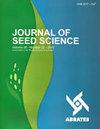Optimum conditions for seed propagation of Garcinia brasiliensis: mimicking natural habitats allows better results
IF 1.2
4区 农林科学
Q3 AGRONOMY
引用次数: 0
Abstract
Abstract: Garcinia brasiliensis is a tropical tree species of economic importance to local populations in the Amazon and Atlantic forests. The plant propagation of this species occurs mostly through seeds and despite that very little information about seedling emergence and growth is currently available. Here we assessed basic information on the seed and seedling ecophysiology of G. brasiliensis aiming at providing key details for seed propagation. Seeds are large and contain high levels of water when recently collected (c. 50%). Seed storage, especially under low temperature, resulted in very low seedling emergence. Fruit storage at c. 25 °C, on the other hand, was demonstrated to be the best option for maintaining seed viability in the short term. Removal of the seed coat considerably hastened and increased the percentage emergence of seedlings, despite the light condition. Similarly, a higher percentage and index of seedling emergence was observed under 35 °C over 25 °C, despite the substrate. Amongst all the substrates tested, sand resulted in lower seedling emergence. Cultivating seedlings in vermiculate and at 25 °C provided the best condition for root and shoot growth. Ideal conditions of light and temperature for seedling emergence and development mirror the environmental conditions under which plants of G. brasiliensis establish in nature.巴西藤种子繁殖的最佳条件:模拟自然栖息地可以获得更好的结果
摘要:巴西藤黄是亚马逊和大西洋森林中对当地种群具有重要经济意义的热带树种。该物种的植物繁殖主要通过种子进行,尽管目前关于幼苗出现和生长的信息很少。在这里,我们评估了巴西G.brasiliensis种子和幼苗生态生理学的基本信息,旨在为种子繁殖提供关键细节。种子很大,最近采集时含水量很高(约50%)。种子储存,特别是在低温下,导致幼苗出苗率很低。另一方面,在c.25°c下储存果实被证明是短期内保持种子活力的最佳选择。尽管在光照条件下,去除种皮大大加快并增加了幼苗的出苗率。同样,尽管有基质,但在35°C下的出苗率和指数高于25°C。在所有测试的基质中,沙子导致幼苗出苗率较低。用蛭石和25°C培养幼苗为根系和地上部的生长提供了最佳条件。幼苗出现和发育的理想光照和温度条件反映了巴西G.brasiliensis植物在自然界中生长的环境条件。
本文章由计算机程序翻译,如有差异,请以英文原文为准。
求助全文
约1分钟内获得全文
求助全文
来源期刊

Journal of Seed Science
Agricultural and Biological Sciences-Agronomy and Crop Science
CiteScore
2.00
自引率
30.00%
发文量
28
审稿时长
12 weeks
期刊介绍:
From 2017 the Journal of Seed Science (JSS) will circulate online version only.
Original scientific studies and communications, not yet published or submitted to another journal for publication and written in Portuguese or English, will be accepted for publication. For manuscripts submitted in English, the authors should provide an adequated version.
The SCIENTIFIC COMMUNICATION is a category of scientific manuscript which describes a technique, an equipment, new species or observations and surveys of limited results. It has the same scientific rigor as the “Scientific Articles” and the same value as a publication. The classification of a manuscript as a SCIENTIFIC COMMUNICATION is based on its content and scientific merit but it can be a preliminary study, simple and not definitive on a certain subject, with publication justified by its uniqueness and contribution to the area.
The Editorial Board of the JSS may invite leading authors of recognized reputation to compose specific Review Articles covering topics of their specialization that will convey to the scientific community the state-of-the-art knowledge related to the specific theme.
 求助内容:
求助内容: 应助结果提醒方式:
应助结果提醒方式:


